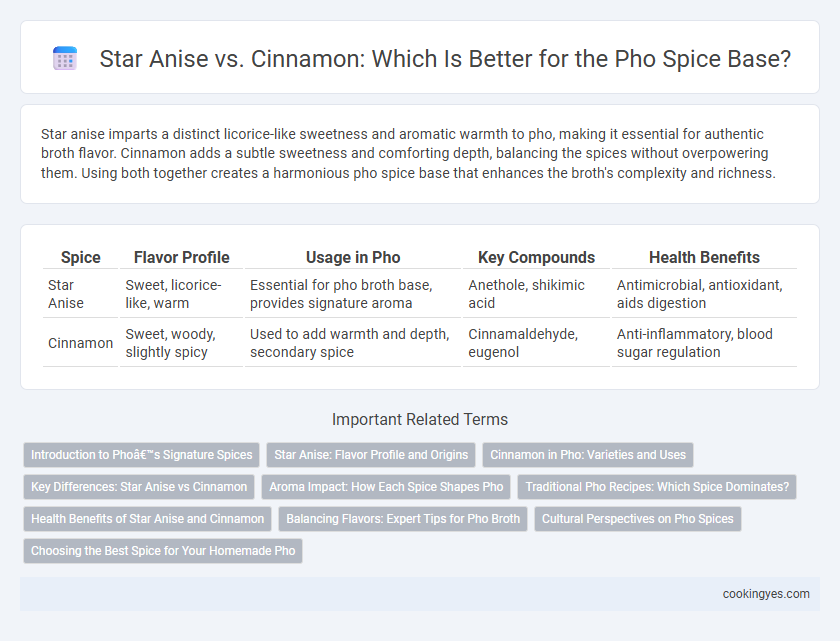Star anise imparts a distinct licorice-like sweetness and aromatic warmth to pho, making it essential for authentic broth flavor. Cinnamon adds a subtle sweetness and comforting depth, balancing the spices without overpowering them. Using both together creates a harmonious pho spice base that enhances the broth's complexity and richness.
Table of Comparison
| Spice | Flavor Profile | Usage in Pho | Key Compounds | Health Benefits |
|---|---|---|---|---|
| Star Anise | Sweet, licorice-like, warm | Essential for pho broth base, provides signature aroma | Anethole, shikimic acid | Antimicrobial, antioxidant, aids digestion |
| Cinnamon | Sweet, woody, slightly spicy | Used to add warmth and depth, secondary spice | Cinnamaldehyde, eugenol | Anti-inflammatory, blood sugar regulation |
Introduction to Pho’s Signature Spices
Star anise and cinnamon are essential spices in Pho's signature aromatic profile, each contributing distinct flavors that define the broth's complexity. Star anise imparts a sweet, licorice-like aroma, while cinnamon adds warm, woody undertones, both crucial for balancing the savory beef or chicken base. These spices, combined with others like cloves and cardamom, create the rich, layered taste that makes Pho a beloved Vietnamese culinary classic.
Star Anise: Flavor Profile and Origins
Star anise delivers a distinct licorice-like flavor with sweet, warm, and mildly spicy notes that form the aromatic backbone of authentic pho broth. Native to southern China and Vietnam, star anise is a key spice in Vietnamese cuisine, prized for its ability to deepen and balance the savory richness of the soup. Its essential oils contain anethole, which contributes to the complexity and signature aroma that differentiates pho from other noodle soups seasoned with cinnamon.
Cinnamon in Pho: Varieties and Uses
Cinnamon in pho primarily includes Saigon and Ceylon varieties, each offering distinct aromatic profiles essential to the broth's flavor complexity. Saigon cinnamon, known for its bold, sweet-spicy aroma, enhances pho with a robust depth, while Ceylon cinnamon provides a delicate, mild sweetness that complements lighter pho recipes. This spice's antimicrobial properties and subtle warmth make it a crucial ingredient in achieving the characteristic balance in traditional Vietnamese pho.
Key Differences: Star Anise vs Cinnamon
Star anise provides a distinct licorice-like aroma and flavor, essential for authentic pho broth, while cinnamon contributes a warm, sweet woody note that balances the spice profile. Star anise contains anethole, giving pho its signature fragrant depth, whereas cinnamon's cinnamaldehyde imparts subtle sweetness and complexity. Combining star anise and cinnamon in pho broth enhances the layered, aromatic flavor characteristic of traditional Vietnamese cuisine.
Aroma Impact: How Each Spice Shapes Pho
Star anise imparts a strong, licorice-like aroma with sweet, slightly peppery notes that define Pho's signature fragrance, creating a warm and complex scent profile. Cinnamon contributes a sweet, woody fragrance with subtle spicy undertones that add depth and a comforting richness to the broth. Combining star anise and cinnamon balances Pho's aroma by blending bold, sharp sweetness with mellow, earthy warmth, enhancing the overall sensory experience.
Traditional Pho Recipes: Which Spice Dominates?
Star anise dominates traditional pho recipes as the key spice, providing the signature licorice-like aroma essential to authentic pho broth. Cinnamon complements the flavor profile with its warm, sweet undertones but remains secondary to star anise in the spice blend. Authentic pho typically uses multiple star anise pods to achieve the depth and complexity characteristic of Vietnamese cuisine.
Health Benefits of Star Anise and Cinnamon
Star anise contains anethole, which provides anti-inflammatory and antimicrobial properties that support digestion and immune health. Cinnamon is rich in antioxidants and has been shown to regulate blood sugar levels while also offering anti-inflammatory benefits. Both spices contribute to the unique flavor profile of pho while enhancing overall wellness through their distinct health-promoting compounds.
Balancing Flavors: Expert Tips for Pho Broth
Star anise imparts a sweet licorice aroma that enhances the pho broth's depth while cinnamon adds warmth and subtle spice, creating a harmonious balance of flavors. Experts recommend using star anise sparingly to prevent overpowering sweetness, combining it with a cinnamon stick to achieve a nuanced, well-rounded spice profile. Balancing these spices carefully ensures the pho broth retains its signature fragrant and savory character without bitterness or excessive sweetness.
Cultural Perspectives on Pho Spices
Star anise holds a more prominent place in traditional Vietnamese pho recipes due to its distinctive licorice-like aroma that defines the broth's signature flavor, while cinnamon contributes warmth and subtle sweetness. The use of these spices varies regionally, with Northern Vietnam favoring a lighter, more aromatic broth emphasizing star anise, and Southern Vietnam incorporating cinnamon for a richer, more robust taste. Cultural perceptions shape the choice of spices, reflecting regional dietary preferences and local ingredient availability in authentic pho preparation.
Choosing the Best Spice for Your Homemade Pho
Star anise offers a strong, licorice-like aroma that defines the classic pho flavor, while cinnamon provides a warm, sweet undertone that balances the broth's complexity. Selecting star anise enhances the authentic taste with its bold, aromatic profile, whereas cinnamon adds subtle sweetness and depth to the spice base. For homemade pho, using star anise as the primary spice creates a more traditional and vibrant broth essential for that signature Vietnamese dish.
Star anise vs cinnamon for pho spice base Infographic

 cookingyes.com
cookingyes.com